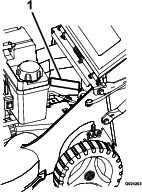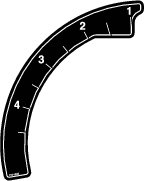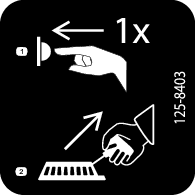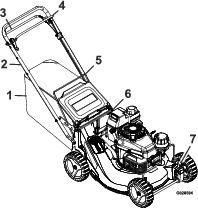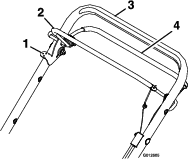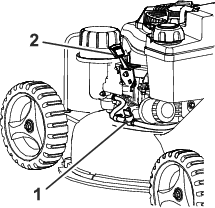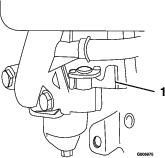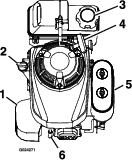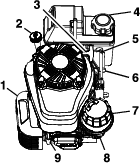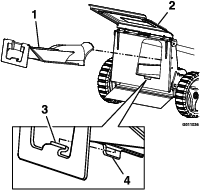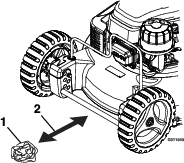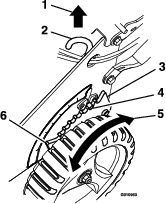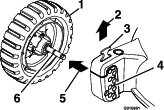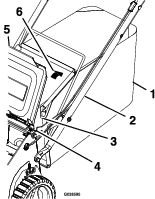Maintenance
Note: Determine the left and right sides of the machine from the normal operating position.
Maintenance Safety
-
Park machine on level ground, stop engine, and disconnect spark plug wire. Wait for all moving parts to stop before leaving the operator’s position. Allow the machine to cool before servicing, adjusting, fueling, cleaning, or storing.
Warning
Tipping the lawn mower may cause the fuel to leak from the carburetor or the fuel tank. Gasoline is extremely flammable, highly explosive, and under certain conditions, can cause personal injury or property damage.
Avoid fuel spills by running the engine dry or by removing the gasoline with a hand pump; never siphon.
-
If you leave the wire on the spark plug, someone could accidently start the engine and seriously injure you or other bystanders. Disconnect the wire from the spark plug before you perform any maintenance or repairs.
-
Never allow untrained personnel to service machine.
-
Keep all guards, shields, switches, and all safety devices in place and in proper working condition. Frequently check for worn or deteriorating components and replace them with genuine Exmark parts when necessary.
Warning
Removal or modification of original equipment, parts and/or accessories may alter the warranty, controllability, and safety of the machine. Unauthorized modifications to the original equipment or failure to use original Exmark parts could lead to serious injury or death. Unauthorized changes to the machine, engine, fuel or venting system, may violate applicable safety standards such as: ANSI, OSHA and NFPA and/or government regulations such as EPA and CARB.
-
Keep hands and feet away from moving parts. If possible, Do Not make adjustments with the engine running.
-
Check all bolts frequently to maintain proper tightness.
Recommended Maintenance Schedule(s)
| Maintenance Service Interval | Maintenance Procedure |
|---|---|
| After the first 5 hours |
|
| Before each use or daily |
|
| Every 25 hours |
|
| Every 40 hours |
|
| Every 50 hours |
|
| Every 100 hours |
|
| Every 250 hours |
|
| Every 300 hours |
|
| Yearly or before storage |
|
Periodic Maintenance
Engine Maintenance
Important: Refer to the Engine Owner’s Manual for additional maintenance procedures.
Engine Safety
Warning
The engine can become very hot, especially the muffler and exhaust components. Touching a hot engine can cause severe burns.
Allow the engine to cool completely before service or making repairs around the engine area.
Do Not change the engine governor setting or overspeed the engine.
Check Engine Oil Level
| Maintenance Service Interval | Maintenance Procedure |
|---|---|
| Before each use or daily |
|
-
Stop engine and wait for all moving parts to stop. Make sure unit is on a level surface.
-
Check with engine cold.
-
Clean area around dipstick. Remove dipstick and wipe oil off. Reinsert the dipstick and push it all the way down into the tube. Do Not screw into place. Remove the dipstick and read the oil level.
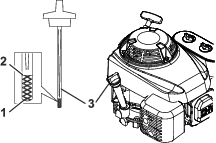
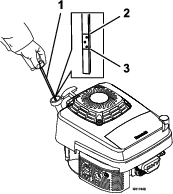
-
If the oil level is low, wipe off the area around the oil fill cap, remove cap and fill to the “FULL” mark on the dipstick. Exmark 4-Cycle Premium Engine Oil is recommended; refer to the Engine Owner's manual for appropriate API rating and viscosity. Do Not overfill.
Important: Do Not operate the engine with the oil level below the “LOW” (or “ADD”) mark on the dipstick, or over the “FULL” mark.
Checking the Blade Brake Clutch (Blade Brake Clutch Only)
| Maintenance Service Interval | Maintenance Procedure |
|---|---|
| Before each use or daily |
|
Refer to Checking the Blade Brake Clutch in the Operating Instructions section.
Checking the Mower Blade
| Maintenance Service Interval | Maintenance Procedure |
|---|---|
| Before each use or daily |
|
Always mow with a sharp blade. A sharp blade cuts cleanly and without tearing or shredding the grass blade.
-
Stop the engine and wait for all moving parts to stop.
-
Disconnect the wire from the spark plug.
-
Drain the gasoline from the fuel tank. Refer to Emptying the Fuel Tank and Cleaning the Fuel Filter section.
-
Tip the lawn mower onto its right side.
-
Inspect the blade for sharpness and wear, especially where the flat and the curved parts meet. Because sand and abrasive material can wear away the metal that connects the flat and curved parts of the blade, check the blade before using the lawn mower. If you notice a slot or wear, replace the blade.
Note: For the best performance, install a new blade before the cutting season begins. During the year, file down any small nicks to maintain the cutting edge.
Danger
A worn or damaged blade can break. A piece of the blade could be thrown into the operator’s or bystander’s area, resulting in serious personal injury or death.
-
Inspect the blade periodically for wear or damage.
-
Replace a worn or damaged blade.
If it is necessary to remove the blade for replacement or sharpening, complete the following steps:
-
To remove the blade, use a block of wood to hold the blade steady (see Figure 18). Make sure to grasp the end of the blade using a rag or a thickly padded glove.
-
For Blade Brake Clutch Units: Remove the blade nuts, blade support, and blade.
-
For Units without a Blade Brake Clutch: Remove the blade bolt, blade support, and blade.
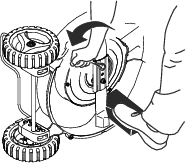
-
-
For Sharpening: File the top side of the blade to maintain its original cutting angle (Figure 19A and B) and inner cutting edge radius (Figure 19A). The blade will remain balanced if you remove the same amount of material from both cutting edges.

-
Check the balance of the blade by placing the center hole of the blade over a nail or screwdriver shank clamped horizontally in a vise (Figure 20). If either end of the blade rotates downward, file that end (not the cutting edge). The blade is properly balanced when neither end drops.

-
For Installation: Make sure to grasp the end of the blade using a rag or a thickly padded glove.
For Blade Brake Clutch Units: Install a sharp, balanced Exmark blade, blade support, and the blade nuts. The sail of the blade must point toward the top of the lawn mower housing for proper installation. Torque the blade nuts to 44-56 ft-lb (60-76 N m).
For Units without a Blade Brake Clutch: Install a sharp, balanced Exmark blade, blade support, and blade bolt. The sail of the blade must point toward the top of the lawn mower housing for proper installation. Torque the blade bolt to 35-45 ft-lb (47-61 N m).
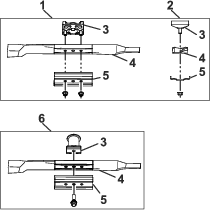
-
-
Return the lawn mower to its upright position.
-
Connect the wire to the spark plug.
Check for Loose Hardware
| Maintenance Service Interval | Maintenance Procedure |
|---|---|
| Before each use or daily |
|
-
Stop engine, wait for all moving parts to stop.
-
Visually inspect machine for any loose hardware or any other possible problem. Tighten hardware or correct the problem before operating.
Check the Blade Brake Clutch Bail Operation (Blade Brake Clutch Units Only)
| Maintenance Service Interval | Maintenance Procedure |
|---|---|
| Before each use or daily |
|
Check the Blade Brake Clutch (BBC) bail operation for any operation problems or deteriorating components, such as the spring. Replace components or correct any problems before operating. Refer to Operating the Blade Control Lever in Operation.
Service Air Filter
| Maintenance Service Interval | Maintenance Procedure |
|---|---|
| Every 25 hours |
|
| Every 300 hours |
|
Note: Do Not operate the engine without the air filter assembly; extreme engine damage will occur.
-
Stop engine, wait for all moving parts to stop.
-
Disconnect the wire from the spark plug.
-
Remove the cover and clean it thoroughly.
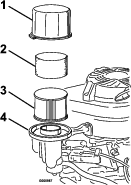
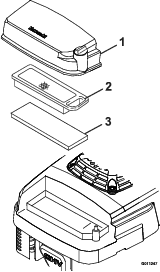
-
Remove the paper air filter and discard it as required.
Note: Do Not try to clean a paper air filter.
-
Remove the foam element and wash it with a mild detergent and water, then blot it dry.
-
Saturate the element with clean engine oil, then squeeze it (Do Not twist) to remove the excess oil.
-
Install the foam element.
-
Install the new paper air filter.
-
Install the cover.
Service Air Filter
| Maintenance Service Interval | Maintenance Procedure |
|---|---|
| Every 25 hours |
|
| Every 250 hours |
|
Note: Do Not operate the engine without the air cleaner assembly; extreme engine damage will occur.
-
Stop the engine and wait for all moving parts to stop.
-
Disconnect the wire from the spark plug.
-
Remove the two wing nuts that secure the cover (Figure 24).
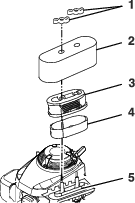
-
Remove the cover.
Note: Be careful to prevent dirt and debris from falling into the base.
-
Remove the foam and paper elements from the base.
-
Remove the foam element from the paper element.
-
Inspect the foam and paper elements, and replace them if they are damaged or excessively dirty.
-
Tap the paper element on a hard surface several times or use compressed air not exceeding 30 psi (207 kPa) through the filter from the wire screen side to remove any excess dirt. If the paper element is excessively dirty, replace it.
Note: Never try to brush dirt off the paper element; brushing forces the dirt into the fibers.
-
Clean the foam element in warm, soapy water or in a nonflammable solvent.
-
Rinse and dry the foam element thoroughly.
-
Dip the foam element in clean engine oil, then squeeze out the excess oil.
Note: Excess oil in the foam element restricts the air flow through the element and may reach the paper filter and clog it.
-
Wipe dirt from the base and the cover with a moist rag.
Note: Be careful to prevent dirt and debris from entering the air duct leading to the carburetor.
-
Install the air cleaner elements and ensure that they are properly positioned.
-
Securely install the cover with the two wing nuts.
Change Engine Oil
| Maintenance Service Interval | Maintenance Procedure |
|---|---|
| After the first 5 hours |
|
| Every 50 hours |
|
-
Run the engine to warm the engine oil.
Note: Warm oil flows better and carries more contaminates.
Warning
Oil may be hot after engine has been run. Contact with hot oil can cause severe personal injury.
Avoid contacting the hot engine oil when you drain it.
-
Stop engine, wait for all moving parts to stop.
-
Disconnect the wire from the spark plug.
-
Drain the gasoline from the fuel tank. Refer to Emptying the Fuel Tank and Cleaning the Fuel Filter section.
-
Place a suitable drain pan under the dipstick/oil drain.
-
Clean around the dipstick.
-
Remove the dipstick by rotating the cap counterclockwise and pulling it out.
-
Raise the left side of the lawn mower to drain the oil from the dipstick fill tube into the drain pan.
-
After draining the oil, return the lawn mower to the operating position.
-
Fill the crankcase with fresh oil to the upper limit mark on the dipstick. Use oil recommended in the Check Engine Oil Level section. Do Not overfill
-
Insert the dipstick into the filler neck and rotate the cap clockwise until it is tight.
-
Wipe up any spilled oil.
-
Connect the wire to the spark plug.
-
Recycle the used oil according to local codes.
Change Oil Filter
| Maintenance Service Interval | Maintenance Procedure |
|---|---|
| Every 100 hours |
|
-
Run the engine to warm the oil.
-
Stop the engine and wait for all moving parts to stop.
-
Disconnect the wire from the spark plug.
-
Drain the engine oil.
-
Place a rag under the oil filter to catch any oil that may leak out as you remove the filter.
-
Remove the oil filter.
-
Use your finger to coat the gasket on the new filter with clean Exmark 4–Cycle Premium Engine oil (see Figure 25).
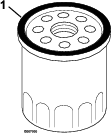
-
Install the new filter and hand tighten it 2/3 turn only.
-
Fill the crankcase as stated in Check Engine Oil Level section. Exmark 4–Cycle Premium Engine oil is recommended. Refer to the Engine Owner's Manual for an acceptable alternative.
-
Connect the wire to the spark plug.
-
Run the engine for about 3 minutes.
-
Stop the engine, wait for all moving parts to stop, and check for oil leakage around the filter.
-
Add oil to compensate for the oil in the oil filter.
-
Recycle the used oil filter according to local codes.
Check Condition Of Belt
| Maintenance Service Interval | Maintenance Procedure |
|---|---|
| Every 40 hours |
|
-
Stop engine, wait for all moving parts to stop.
-
Remove the belt cover to the lawn mower housing.
-
Check the belt for cracks, frayed edges, burn marks or any other damage.
-
Replace the damaged belt.
Check Spark Plugs
| Maintenance Service Interval | Maintenance Procedure |
|---|---|
| Every 100 hours |
|
-
Stop the engine and wait for all moving parts to stop.
-
Disconnect the wire from the spark plug (see Figure 8 and Figure 26).
-
Clean around the spark plug.
-
Remove the spark plug from the cylinder head.
Note: Replace a cracked, fouled, or dirty spark plug. Do Not clean the electrodes because grit entering the cylinder can damage the engine.
-
Set the gap on the plug to 0.030 inch (0.76 mm) (Figure 26).

-
Install the spark plug and the gasket seal.
-
Torque the plug to 17 ft-lb (23 N-m).
-
Connect the wire to the spark plug.
Emptying the Fuel Tank and Cleaning the Fuel Filter
| Maintenance Service Interval | Maintenance Procedure |
|---|---|
| Every 50 hours |
|
| Every 100 hours |
|
The fuel filter (screen) element is located inside the fuel tank (if applicable).
-
Stop the engine and wait for it to cool down.
Note: Drain gasoline for a cold engine only.
-
Disconnect the wire from the spark plug.
-
Close the fuel valve.
-
Disconnect the fuel line by loosening the tube clamp at the carburetor.
-
Open the fuel valve by turning the lever to the open position.
-
Drain the gasoline completely from the tank and fuel line into an approved fuel container.
-
Remove the fuel tank from the mower.
-
Close the fuel valve.
-
Pour a small amount of fuel in the fuel tank, move the fuel around in the tank, and pour it out into an approved fuel container.
-
Install the fuel tank and fuel line.
Adjustments
Note: Wait for all moving parts to stop and remove spark plug wire before servicing, cleaning, or making any adjustments to the unit.
Adjusting the Self-Propel Drive
If the lawn mower does not self-propel or has a tendency to creep forward when the control bail is released, adjust the drive cable nuts as shown in Figure 28.
Danger
Checking the operation of the mower with the belt cover removed will allow debris to be thrown in the operator's or bystander's direction and can result in serious personal injury or death.
Do Not operate the unit when cover is not in place.
-
Stop the engine and wait for all moving parts to stop.
-
Remove the belt cover by pulling upward on the back of the cover to unsnap the front and back cover tabs. Remove any debris under the cover.
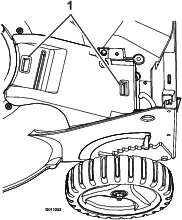
-
If the lawn mower does not self propel with bail engaged, tighten the belt by turning the drive cable nuts clockwise. To maximize belt life, Do Not overtighten the belt.
If the lawn mower creeps forward without the bail engaged, loosen the belt by turning the drive cable nuts counterclockwise.
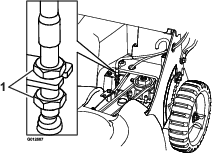
-
Reinstall the belt cover by pushing down on the rear first and then snapping the front onto the mower housing.
-
Check the operation for desired drive control.
-
Repeat steps 2 through 5 as necessary for further adjustment.
Note: Adjustment to obtain desired ground speed at full bail travel may be made in order to accommodate slower speeds.
Adjusting the Blade Brake Cable
Adjust whenever a new blade brake cable assembly is installed or if the blade control lock lever does not operate properly.
-
Stop the engine and wait for all moving parts to stop.
-
Disconnect the wire from the spark plug.
-
Remove the belt cover by pulling upward on the back of the cover to unsnap the front and back cover tabs (see Figure 27). Remove any debris under the cover.
-
Loosen the cable clamp screw until the cable conduit slides (see Figure 29).
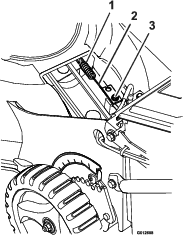
-
Pull the cable until there is approximately 1/8 inch in slack. Do Not put tension on the spring.
-
Tighten the screw to lock the adjustment in place.
-
Reinstall the belt cover by pushing down on the rear first and then snapping the front onto the mower housing.
-
Connect the wire to the spark plug.
-
Check the operation of the blade control lock lever (see Figure 10). The lever must reset itself to lock out the blade control bail. If it does not, repeat steps 4 through 8.
-
Perform the “Checking the Blade Brake Clutch (Blade Brake Clutch Units Only)” procedure in Operation.
Cleaning
Cleaning and Storing Safety
-
Park machine on level ground, stop engine, and disconnect spark plug wire. Wait for all moving parts to stop before leaving the operator’s position. Allow the machine to cool before servicing, adjusting, fueling, cleaning, or storing.
-
Clean grass and debris from the cutting unit, muffler, drives, grass catcher, and engine compartment to prevent fires.
-
Allow the machine to cool before storing the machine in any enclosure. Do not store the machine or fuel container, or refuel, where there is an open flame, spark, or pilot light such as on a water heater or other appliance.
Clean Grass Build-Up Under Deck
| Maintenance Service Interval | Maintenance Procedure |
|---|---|
| Before each use or daily |
|
-
Stop engine, wait for all moving parts to stop, and remove spark plug wire.
-
To ensure the best performance, keep the underside of the lawn mower housing clean.
Caution
The mower may dislodge material from under the mower housing.
-
Wear eye protection.
-
Stay in the operating position (behind the handle).
-
Do Not allow bystanders in the area.
-
Washing Method
-
Position the lawn mower on a flat concrete or asphalt surface near a garden hose.
-
Start the engine.
-
Hold the running garden hose at handle level and direct the water to flow on the ground just in front of the right rear tire (Figure 30).

-
Engage the blade.
Note: The blade will draw in water and wash out clippings. Let the water run until you no longer see clippings being washed out from under the housing.
-
Disengage the blade, stop the engine and wait for all moving parts to stop.
-
Turn off the water.
-
Start the lawn mower, engage the blade, and let the lawn mower run for a few minutes to dry out its components.
Scraping Method
If washing does not remove all debris from under the lawn mower, scrape it clean.
-
Disconnect the wire from the spark plug.
-
Drain the fuel from the fuel tank. Refer to Emptying the Fuel Tank and Cleaning the Fuel Filter section.
-
Tip the lawn mower onto its right side.
-
Remove the dirt and grass clippings with a hardwood scraper. Avoid burrs and sharp edges.
-
Turn the lawn mower upright.
-
Fill the fuel tank.
-
Connect the wire to the spark plug.
Cleaning the Discharge Tunnel and Plug
| Maintenance Service Interval | Maintenance Procedure |
|---|---|
| Before each use or daily |
|
Always be sure that the discharge tunnel door closes securely when you release the handle. If the debris prevents the discharge door from closing securely, clean the inside of the discharge tunnel and the door thoroughly.
Warning
Grass clippings and other objects can be thrown from an open discharge tunnel. Thrown objects can cause serious injury or kill the operator or bystanders.
Never start or operate the lawn mower unless one of the following is true:
-
Mulch Mode:
-
The discharge tunnel plug is locked securely in the discharge tunnel.
-
The discharge tunnel door is closed against frame.
-
-
Bag Mode:
-
The discharge tunnel plug is removed.
-
The grass bag is locked in place.
-
The discharge tunnel door is closed against bag.
-
-
Optional Rear Discharge Mode:
-
The optional rear discharge deflector is locked in place.
-
The discharge tunnel door is closed against deflector.
-
Cleaning Under the Belt Cover (Self-Propelled Units Only)
| Maintenance Service Interval | Maintenance Procedure |
|---|---|
| Every 50 hours |
|
-
Stop the engine and wait for all moving parts to stop.
-
Disconnect the wire from the spark plug.
-
Pull upward on the back of the cover to unsnap the front and back cover tabs (see Figure 27).
-
Lift off the cover and brush out all the debris around the belt area.
-
Install the belt cover by pushing down on the rear first and then snapping the front onto the mower housing.
-
Connect the wire to the spark plug.
Cleaning the Blade Brake Clutch Shield
| Maintenance Service Interval | Maintenance Procedure |
|---|---|
| Every 50 hours |
|
-
Stop the engine and wait for all moving parts to stop.
-
Disconnect the wire from the spark plug.
-
Drain the gasoline from the fuel tank. Refer to Emptying the Fuel Tank and Cleaning the Fuel Filter section.
-
Tip the lawn mower onto its right side (air filter up).
-
Remove the blade nuts and the blade.
-
Remove the three screws holding the BBC shield onto the machine (see Figure 31).
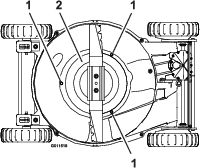
-
Remove the BBC shield and brush or blow all the debris from under the shield and around the BBC system.
-
Install the BBC shield. Tighten the screws to secure the BBC shield to the deck.
-
Install the blade and the two blade nuts. Torque the blade nuts to 44-56 ft-lb (60-76 N m).
-
Turn the lawn mower upright.
-
Connect the wire to the spark plug.
Cleaning Under the Cover Plate (Non-Blade Brake Clutch Units Only)
| Maintenance Service Interval | Maintenance Procedure |
|---|---|
| Every 50 hours |
|
-
Stop the engine and wait for all moving parts to stop.
-
Disconnect the wire from the spark plug.
-
Drain the gasoline from the fuel tank. Refer to Emptying the Fuel Tank and Cleaning the Fuel Filter section.
-
Tip the lawn mower onto its right side (air filter up).
-
Remove the blade bolt, blade support, and the blade (see Figure 32).
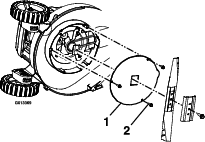
-
Remove the three screws holding the cover plate onto the unit (see Figure 32).
-
Remove the cover plate and brush or blow all the debris from under the plate. Reinstall the cover plate.
-
Install the blade, blade support, and the blade bolt. Torque the blade bolt to 35-45 ft-lb (47-61 N m).
-
Turn the lawn mower upright.
-
Connect the wire to the spark plug.
Waste Disposal
Motor Oil Disposal
Engine oil is a pollutant to the environment. Dispose of used oil at a certified recycling center or according to your state and local regulations.
